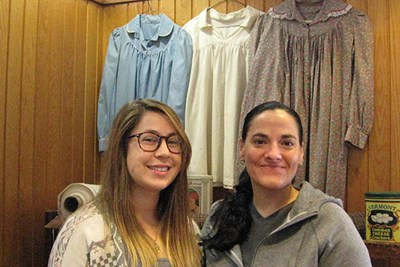History Students Unearth Historic Letter to JFK
 Image by K. Webster
Image by K. Webster
03/22/2018
By Katharine Webster
It was a “Eureka!” moment for two history students researching Portuguese immigration to Lowell for an award-winning museum exhibit.
Kady Phelps and Molly Mahoney were sorting through documents at the John F. Kennedy Presidential Library in Boston a year ago when they discovered a 1958 letter from Firmo Correa, a leader in Lowell’s Portuguese community, to Kennedy, then a U.S. senator.
Correa asked Kennedy to help lift strict limits on Portuguese immigration so that refugees from a natural disaster – the eruption of Capelinhos Volcano and continuing earthquakes on Faial Island in the Azores – could enter the United States. Correa wrote movingly of the island’s destruction and the refugees’ starvation and suffering, signing himself “your humble Portuguese friend.”
Kennedy and Sen. John Pastore of Rhode Island co-sponsored the Azorean Refugee Act of 1958, which passed within months and was renewed in 1960. Some 12,000 people arrived under the act, and most settled in New England mill towns like Lowell that had well-established Portuguese communities.
But no one knew what had prompted Kennedy to act – until Phelps and Mahoney found the letter.
“We knew we had something unique,” says Mahoney, a senior history major in the bachelor’s-to-master’s program. “Nobody had known about this letter, and we knew the community would want to know.”
Sure enough, when the exhibit premiered at the Boott Cotton Mills Museum in December for a conference on Portuguese migration and mill work, several people from Lowell told Phelps and Mahoney that they’d known Correa – but he’d never mentioned writing to Kennedy.
Phelps and Mahoney won the Excellence in Students Cultural Heritage Award for the exhibit from the Lowell National Historical Park and the Lowell Heritage Partnership.
 Image by Tory Wesnofske
Image by Tory Wesnofske
The pair began by digging through 50 boxes of musty immigration records that came from Lowell City Hall. Some documents involved immigrants who were still alive. Phelps and Mahoney tried to track them down and contacted the descendants of others.
They reached out to more Portuguese-Americans through St. Anthony of Padua Catholic Church, the Portuguese American Civic League, the Holy Ghost Society, social clubs and businesses. And they continued their archival research at the Center for Lowell History, City Hall and the JFK Library – where Correa’s letter crystalized their ideas for the exhibit.
“We knew we wanted to focus on people’s personal histories and relate them to broader themes,” Mahoney says.
“We didn’t want to retell the story of the mills,” adds Phelps ’17, who will complete her master’s in history this May.
Personal Journey
For Phelps, the project also offered a chance to further explore her family history. Her maternal great-grandparents, Manuel and Hilda Pestana, were among the earliest wave of immigrants to Lowell, arriving in 1910 from the Madeira Islands. One of their sons, Phelps’ grandfather Henry Pestana, began working in the mills at age 16 and eventually became a warp rigger.
Henry Pestana also was an enthusiastic amateur historian, Phelps says. He contributed a chapter to University Historian Mary Blewett’s book “The Last Generation: Work and Life in the Textile Mills of Lowell,” and in retirement he helped the staff of the newly opened Lowell National Historical Park figure out how to get the looms running in the Boott Cotton Mills Museum, then became a permanent volunteer.
He also documented his family’s life in his diary and thousands of photos, a few of which are included in one of the exhibit panels.
“He was an antiquarian of his time,” says Phelps. “His love of history became a godsend. It’s a historian’s dream.”
Mahoney, who grew up in Lowell, also uncovered a family connection. When discussing the project with her father, she learned that his longtime friend Celestino “Sal” Caires was Portuguese. One of Sal’s nephews had assembled a family history in photos, documents and newspaper clippings – and handed Mahoney and Phelps the entire binder. The Caires family story became another panel.
 Image by Tory Wesnofske
Image by Tory Wesnofske
“Professor Forrant told us we were history detectives. I thought that was really cool,” Mahoney says. “He gave us a lot of freedom.”
Lowell’s Portuguese-American community turned out in force for the formal opening of the exhibit in University Crossing in February. The exhibit will remain there until the end of March and then go to UMass Dartmouth, which houses the Center for Portuguese Studies and Culture and the Ferreira-Mendes Portuguese American Archives. It will also be displayed at the Lowell Folk Festival this summer.
Mahoney hopes it will find a permanent home at the Boott Cotton Mills Museum, where she attended summer camp for years and began volunteering when she was 13 – and where she plans to work as a museum teacher after graduation.
Phelps, who volunteers for the Concord Museum, hopes to work there after she completes her master’s degree in December. Creating the Portuguese exhibit was great experience, she says.
“This allowed us to work with primary sources,” she says. “And it confirmed for me that I love museum work.”



